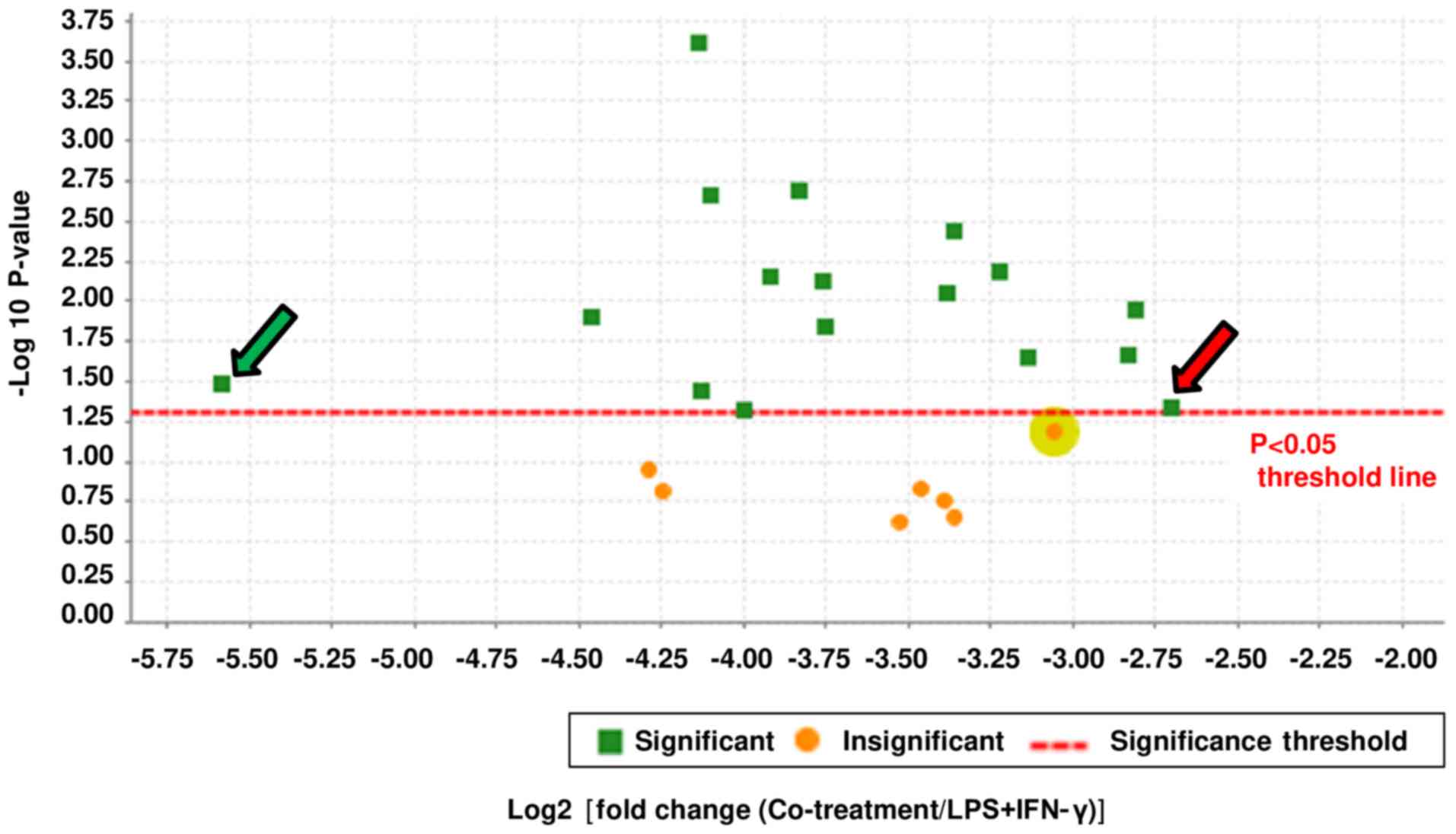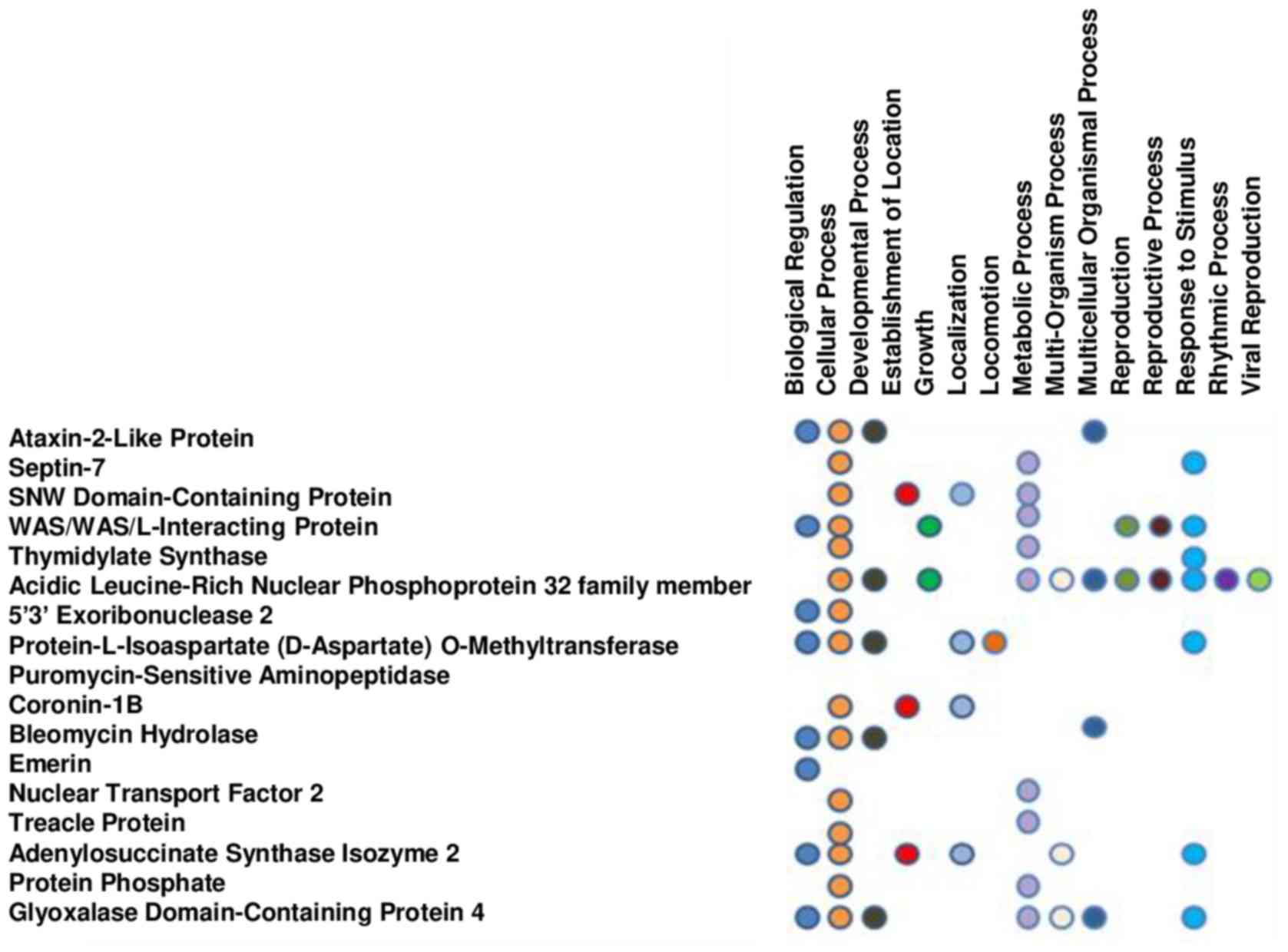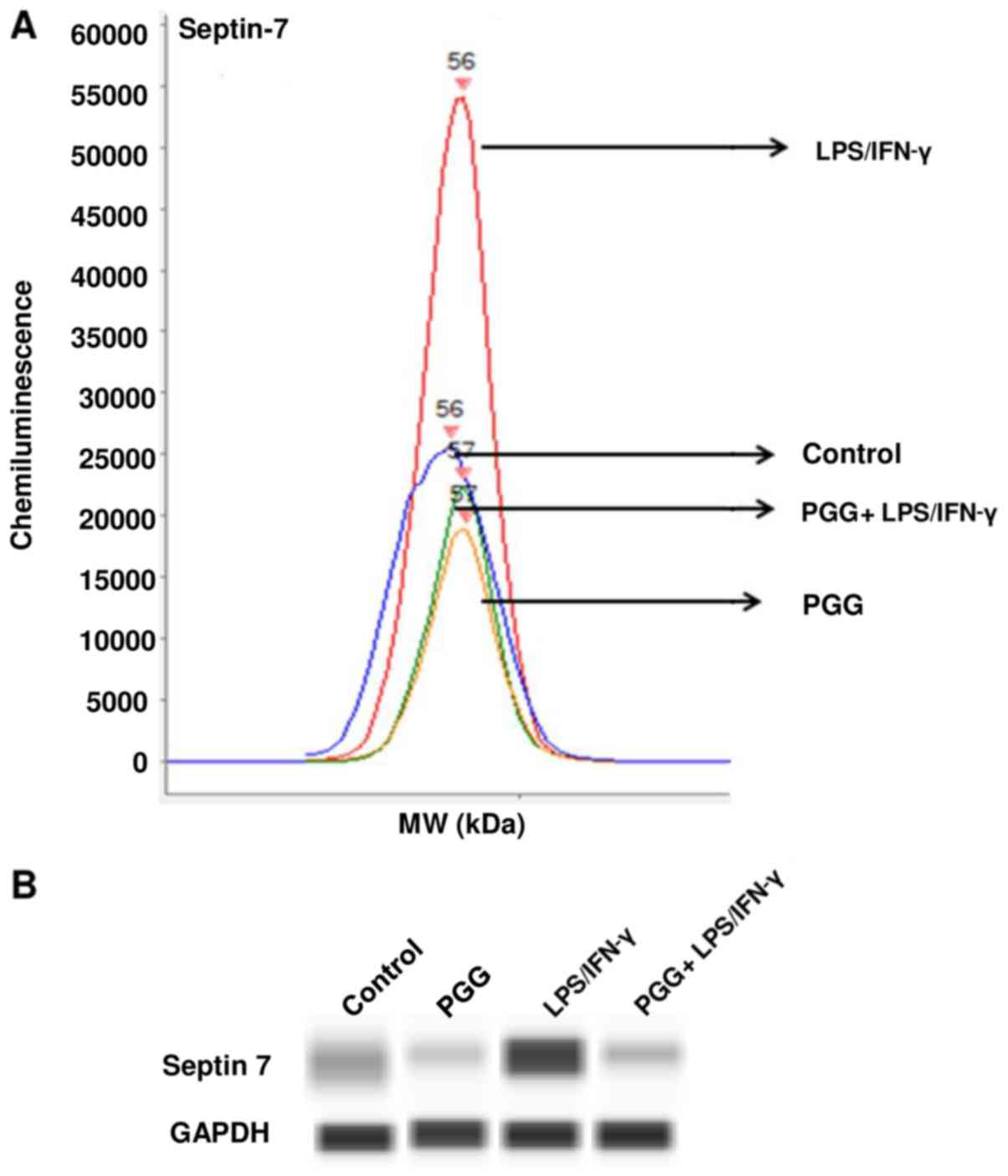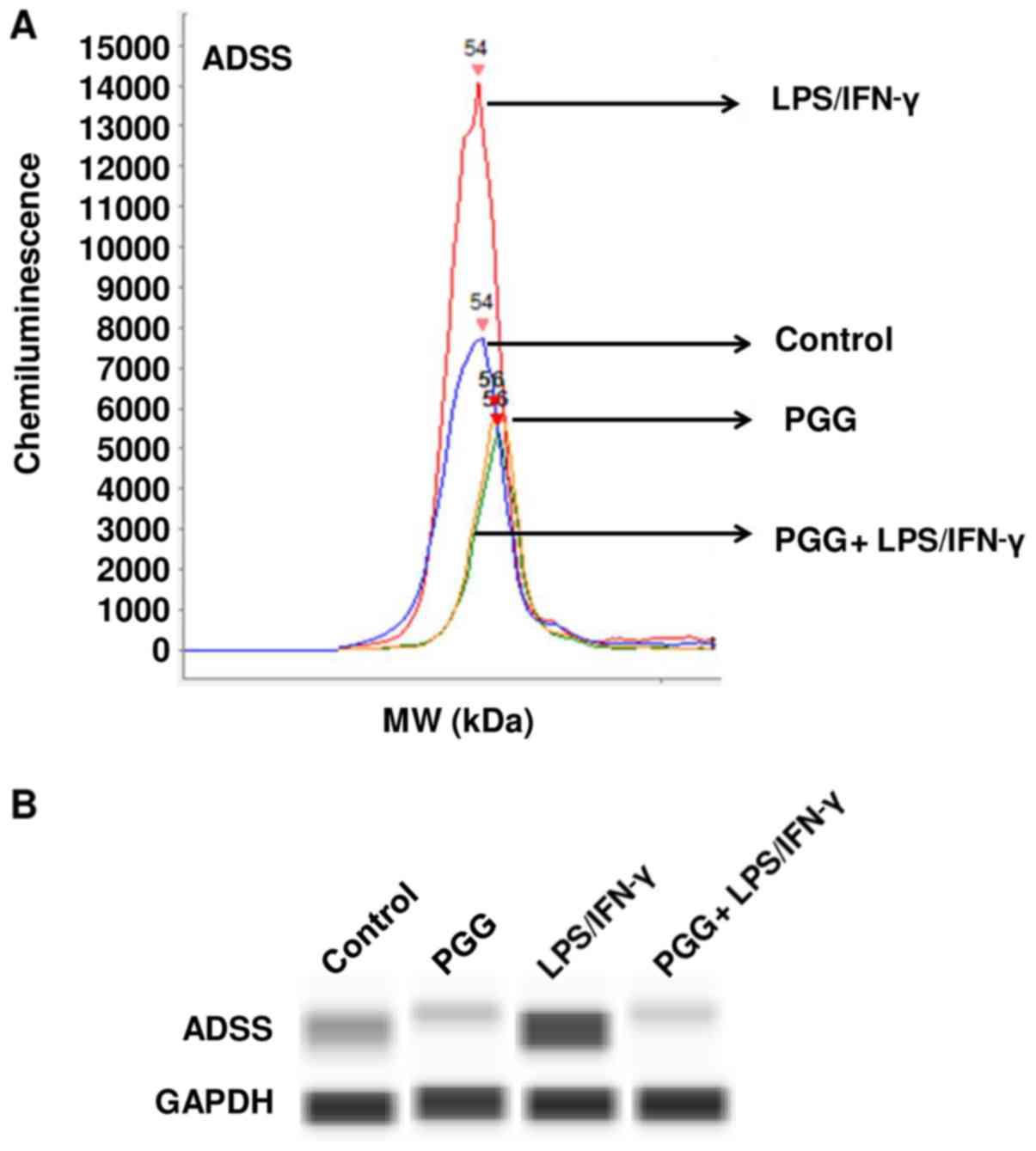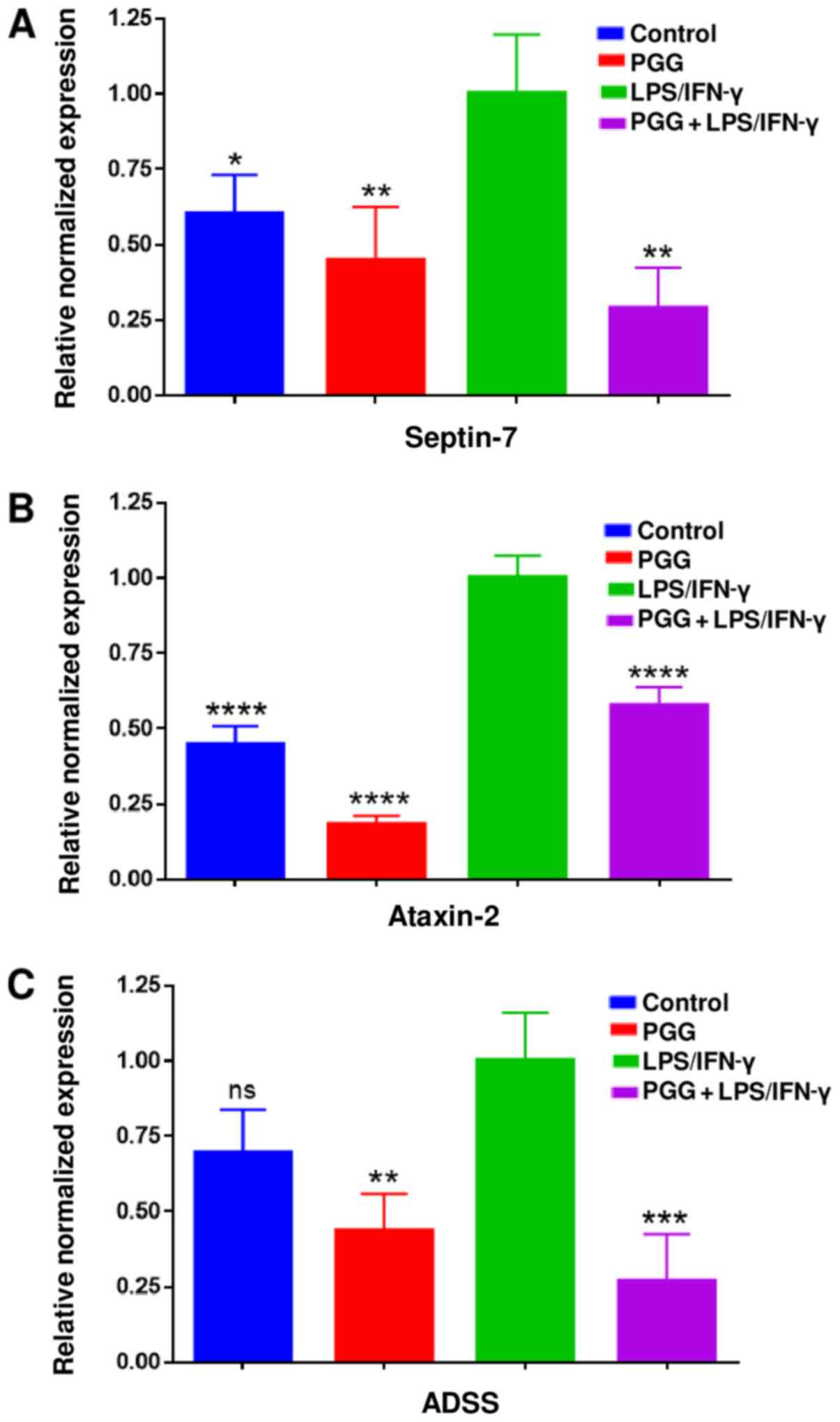|
1
|
Street WJ, Mark RE and Griffin WS:
Microglia and neuroinflammation: A pathological perspective. J
Neuroinflammation. 1:142004. View Article : Google Scholar : PubMed/NCBI
|
|
2
|
Henn A, Lund S, Hedtjärn M, Schrattenholz
A, Pörzgen P and Leist M: The suitability of BV-2 cells as an
alternative model system for primary microglia cultures for animal
experiments examining brain inflammation. ALTEX. 26:83–94. 2009.
View Article : Google Scholar : PubMed/NCBI
|
|
3
|
Schwartz M and Baruch K: The resolution of
neuroinflammation in neurodegeneration: Leukocyte recruitment via
the choroid plexus. EMBO J. 33:7–22. 2014. View Article : Google Scholar : PubMed/NCBI
|
|
4
|
Gendelman HE: Neural immunity: Friend or
foe? J Neurovirol. 8:474–479. 2002. View Article : Google Scholar : PubMed/NCBI
|
|
5
|
Oh GS, Pae HO, Choi BM, Lee HS, Kim IK,
Yun YG, Kim JD and Chung HT: Penta-O-galloyl-Beta-D-glucose
inhibits phorbol myristate acetate-induced interleukin-8
[correction of interleukin-8] gene expression in human monocytic
U937 cells through its inactivation of nuclear factor-kappa B. Int
Immunopharmacol. 4:377–386. 2004. View Article : Google Scholar : PubMed/NCBI
|
|
6
|
Hanisch UK: Microglia as a source and
target of cytokines. Glia. 40:140–155. 2002. View Article : Google Scholar : PubMed/NCBI
|
|
7
|
Gao HM and Hong JS: Why neurodegenerative
diseases are progressive: Uncontrolled inflammation drives disease
progression. Trends Immunol. 29:357–365. 2008. View Article : Google Scholar : PubMed/NCBI
|
|
8
|
Etminan M, Gill S and Samii A: Effect of
non-steroidal anti-inflammatory drugs on risk of Alzheimer's
disease: Systematic review and meta-analysis of observational
studies. BMJ. 327:1282003. View Article : Google Scholar : PubMed/NCBI
|
|
9
|
McGeer PL and McGeer EG: The amyloid
cascade-inflammatory hypothesis of Alzheimer disease: Implications
for therapy. Acta Neuropathol. 126:479–497. 2013. View Article : Google Scholar : PubMed/NCBI
|
|
10
|
Heneka MT, Kummer MP, Weggen S, Bulic B,
Multhaup G, Münter L, Hüll M, Pflanzner T and Pietrzik CU:
Molecular mechanisms and therapeutic application of NSAIDs and
derived compounds in Alzheimer's disease. Curr Alzheimer Res.
8:115–131. 2011. View Article : Google Scholar : PubMed/NCBI
|
|
11
|
Cao Y, Himmeldirk KB, Qian Y, Ren Y, Malki
A and Chen X: Biological and biomedical functions of
Penta-O-Galloyl-D-Glucose and its derivatives. J Nat Med.
68:465–472. 2014. View Article : Google Scholar : PubMed/NCBI
|
|
12
|
Mendonca P, Taka E, Bauer D,
Cobourne-Duval M and Soliman KF: The attenuating effects of
1,2,3,4,6 Penta-O-Galloyl-β-D-glucose on inflammatory cytokines
release from activated BV-2 microglial cells. J Neuroimmunol.
305:9–15. 2017. View Article : Google Scholar : PubMed/NCBI
|
|
13
|
Mendonca P, Taka E, Bauer D, Reams RR and
Soliman KFA: The attenuating effects of 1,2,3,4,6
penta-O-galloyl-β-D-glucose on pro-inflammatory responses of
LPS/IFNγ-activated BV-2 microglial cells through NFκB and MAPK
signaling pathways. J Neuroimmunol. 324:43–53. 2018. View Article : Google Scholar : PubMed/NCBI
|
|
14
|
Blasi E, Barluzzi R, Bocchini V, Mazzolla
R and Bistoni F: Immortalization of murine microglial cells by a
v-raf/v-myc carrying retrovirus. J Neuroimmunol. 27:229–237. 1990.
View Article : Google Scholar : PubMed/NCBI
|
|
15
|
Elsisi N, Darling-Reed S, Lee EY, Oriaku
ET and Soliman KF: Ibuprofen and apigenin induce apoptosis and cell
cycle arrest in activated microglia. Neurosci Lett. 375:91–96.
2005. View Article : Google Scholar : PubMed/NCBI
|
|
16
|
NCBI Resource Coordinators: Database
resources of the National Center for Biotechnology Information.
Nucleic Acids Res. 44:D7–D19. 2016. View Article : Google Scholar : PubMed/NCBI
|
|
17
|
Thomas PD, Campbell MJ, Kejariwal A, Mi H,
Karlak B, Daverman R, Diemer K, Muruganujan A and Narechania A:
PANTHER: A library of protein families and subfamilies indexed by
function. Genome Res. 13:2129–2141. 2003. View Article : Google Scholar : PubMed/NCBI
|
|
18
|
Amor S, Peferoen LA, Vogel DY, Breur M,
van der Valk P, Baker D and van Noort JM: Inflammation in
neurodegenerative diseases-an update. Immunology. 142:151–166.
2014. View Article : Google Scholar : PubMed/NCBI
|
|
19
|
Abdelwahed A, Bouhlel I, Skandrani I,
Valenti K, Kadri M, Guiraud P, Steinman R, Mariotte AM, Ghedira K,
Laporte F, et al: Study of antimutagenic and antioxidant activities
of Gallic acid and 1,2,3,4,6 penta galloyl glucose from Pistacia
lentiscus. Confirmation by microarray expression profiling. Chem
Biol Interact. 165:1–13. 2007. View Article : Google Scholar : PubMed/NCBI
|
|
20
|
Kim BH, Choi MS, Lee HG, Lee SH, Noh KH,
Know S, Jeong AJ, Lee H, Yi EH, Park JY, et al: The photoprotective
potential of penta-O-galloyl-β-D-glucose by targeting NF-κB and
MAPK signaling in UVB radiation-induced human dermal fibroblasts
and mouse skin. Mol Cells. 38:982–990. 2015. View Article : Google Scholar : PubMed/NCBI
|
|
21
|
Aithal M and Belur P: Enhancement of
propyl gallate yield in a nonaqueous medium using novel
cell-associated tannase of Bacillus massiliensis. Prep Biochem
Biotechnol. 43:445–455. 2013. View Article : Google Scholar : PubMed/NCBI
|
|
22
|
Wang KJ, Yang CR and Zhang YJ: Phenolic
antioxidants from Chinese toon (fresh young leaves and shoots of
Toona sinensis). Food Chemistry. 101:365–371. 2006. View Article : Google Scholar
|
|
23
|
Fujiwara H, Tabuchi M, Yamaguchi T,
Iwasaki K, Furukawa K, Sekiguchi K, Ikarashi Y, Kudo Y, Higuchi M,
Saido TC, et al: Traditional medicinal herb Paeonia suffruticosa
and its active constituent
1,2,3,4,6-Penta-O-Galloyl-Beta-D-Glucopyranose have potent
anti-aggregation effects on Alzheimer's amyloid beta proteins in
vitro and in vivo. J Neurochem. 109:1648–1657. 2009. View Article : Google Scholar : PubMed/NCBI
|
|
24
|
De Almeida NEC, Do TD, LaPointe NE, Tro M,
Feinstein SC, Shea JE and Bowers MT:
1,2,3,4,6-Penta-O-Galloyl-β-D-glucopyranose binds to the N-terminal
metal binding region to inhibit amyloid β-protein oligomer and
fibril formation. Int J Mass Spectrom. 420:24–34. 2017. View Article : Google Scholar : PubMed/NCBI
|
|
25
|
Stansley B, Post J and Hensley K: A
comparative review of cell culture systems for the study of
microglial biology in Alzheimer's disease. J Neuroinflammation.
9:1152012. View Article : Google Scholar : PubMed/NCBI
|
|
26
|
Kinoshita A, Kinoshita M, Akiyama H,
Tomimoto H, Akiguchi I, Kumar S, Noda M and Kimura J:
Identification of septins in neurofibrillary tangles in Alzheimer's
disease. Am J Pathol. 153:1551–1560. 1998. View Article : Google Scholar : PubMed/NCBI
|
|
27
|
Tada T, Simonetta A, Batterton M,
Kinoshita M, Edbauer D and Sheng M: Role of septin cytoskeleton in
spine morphogenesis and dendrite development in neurons. Curr Biol.
17:1752–1758. 2007. View Article : Google Scholar : PubMed/NCBI
|
|
28
|
Walikonis RS, Jensen ON, Mann M, Provance
DW Jr, Mercer JA and Kennedy MB: Identification of proteins in the
postsynaptic density fraction by mass spectrometry. J Neurosci.
20:4069–4080. 2000. View Article : Google Scholar : PubMed/NCBI
|
|
29
|
Barr AM, Young CE, Sawada K, Trimble WS,
Phillips AG and Honer WG: Abnormalities of presynaptic protein
CDCrel-1 in the striatum of rats reared in social isolation:
Relevance to neural connectivity in schizophrenia. Eur J Neurosci.
20:303–307. 2004. View Article : Google Scholar : PubMed/NCBI
|
|
30
|
Ageta-Ishihara N, Yamakado H, Morita T,
Hattori S, Takao K, Miyakawa T, Takahashi R and Kinoshita M:
Chronic overload of SEPT4, a parkin substrate that aggregates in
Parkinson's disease, causes behavioral alterations but not
neurodegeneration in mice. Mol Brain. 6:352013. View Article : Google Scholar : PubMed/NCBI
|
|
31
|
Dong Z, Ferger B, Paterna JC, Vogel D,
Furler S, Osinde M, Feldon J and Büeler H: Dopamine-dependent
neurodegeneration in rats induced by viral vector-mediated
overexpression of the parkin target protein, CDCrel-1. Proc Natl
Acad Sci USA. 100:12438–12443. 2003. View Article : Google Scholar : PubMed/NCBI
|
|
32
|
Gozal YM, Seyfried NT, Gearing M, Glass
JD, Heilman CJ, Wuu J, Duong DM, Cheng D, Xia Q, Rees HD, et al:
Aberrant septin 11 is associated with sporadic frontotemporal lobar
degeneration. Mol Neurodegener. 6:822011. View Article : Google Scholar : PubMed/NCBI
|
|
33
|
Ihara M, Yamasaki N, Hagiwara A, Tanigaki
A, Kitano A, Hikawa R, Tomimoto H, Noda M, Takanashi M, Mori H, et
al: Sept4, a component of presynaptic scaffold and Lewy bodies, is
required for the suppression of alpha-synuclein neurotoxicity.
Neuron. 53:519–533. 2007. View Article : Google Scholar : PubMed/NCBI
|
|
34
|
Pissuti Damalio JC, Garcia W, Alves Macedo
JN, De Almeida Marques I, Andreu JM, Giraldo R, Garratt RC and
Ulian Araújo AP: Self-assembly of human septin 2 into amyloid
filaments. Biochimie. 94:628–636. 2012. View Article : Google Scholar : PubMed/NCBI
|
|
35
|
Zhang Y, Gao J, Chung KK, Huang H, Dawson
VL and Dawson TM: Parkin functions as an E2-dependent
ubiquitin-protein ligase and promotes the degradation of the
synaptic vesicle-associated protein, CDCrel-1. Proc Natl Acad Sci
USA. 97:13354–13359. 2000. View Article : Google Scholar : PubMed/NCBI
|
|
36
|
Crunkhorn S: Neurodegenerative disorders:
Ataxin 2 reduction rescues motor defects. Nat Rev Drug Discov.
16:384–385. 2017. View Article : Google Scholar : PubMed/NCBI
|
|
37
|
Schmidt EE, Pelz O, Buhlmann S, Kerr G,
Horn T and Boutros M: RNAi: A database for cell-based and in vivo
RNAi phenotypes, 2013 update. Nucleic Acids Res. 41:D1021–D1026.
2013. View Article : Google Scholar : PubMed/NCBI
|
|
38
|
Stayton MM, Rudolph FB and Fromm HJ:
Regulation, genetics, and properties of adenylosuccinate
synthetase. Curr Top Cell Regul. 22:103–141. 1983. View Article : Google Scholar : PubMed/NCBI
|
|
39
|
Borza T, Iancu CV, Pike E, Honzatko RB and
Fromm HJ: Variations in the response of mouse isozymes of
adenylosuccinate synthetase to inhibitors of physiological
relevance. J Biol Chem. 278:6673–6679. 2003. View Article : Google Scholar : PubMed/NCBI
|
|
40
|
Oshchepkova-Nedosekina EA and Likhoshvai
VA: A mathematical model for the adenylosuccinate synthetase
reaction involved in purine biosynthesis. Theor Biol Med Model.
4:112007. View Article : Google Scholar : PubMed/NCBI
|
|
41
|
Nomura Y, Nozawa A and Tozawa Y:
Biochemical analyses of ppGpp effect on adenylosuccinate
synthetases, key enzymes in purine biosynthesis in rice. Biosci
Biotechnol Biochem. 78:1022–1025. 2014. View Article : Google Scholar : PubMed/NCBI
|
|
42
|
Sowell RA, Owen JB and Butterfield DA:
Proteomics in animal models of Alzheimer's and Parkinson's
diseases. Ageing Res Rev. 8:1–17. 2009. View Article : Google Scholar : PubMed/NCBI
|
|
43
|
Jin J, Meredith GE, Chen L, Zhou Y, Xu J,
Shie FS, Lockhart P and Zhang J: Quantitative proteomic analysis of
mitochondrial proteins: Relevance to Lewy body formation and
Parkinson's disease. Brain Res. Mol. Brain Res. 134:119–138.
2005.
|
|
44
|
Wan W, Xia S, Kalionis B, Liu L and Li Y:
The role of Wnt signaling in the development of Alzheimer's
disease: A potential therapeutic target? Biomed Res Int.
2014:3015752014. View Article : Google Scholar : PubMed/NCBI
|
|
45
|
Zhang T, Shen X, Liu R, Zhu G, Bishop J
and Xing M: Epigenetically upregulated WIPF1 plays a major role in
BRAF V600E-promoted papillary thyroid cancer aggressiveness.
Oncotarget. 8:900–914. 2017.PubMed/NCBI
|
|
46
|
Pestalozzi BC, Peterson HF, Gelber RD,
Goldhirsch A, Gusterson BA, Trihia H, Lindtner J, Cortés-Funes H,
Simmoncini E, Byrne MJ, et al: Prognostic importance of thymidylate
synthase expression in early breast cancer. J Clin Oncol.
15:1923–1931. 1997. View Article : Google Scholar : PubMed/NCBI
|
|
47
|
Johnston PG, Lenz HJ, Leichman CG,
Danenberg KD, Allegra CJ, Danenberg PV and Leichman L: Thymidylate
synthase gene and protein expression correlate and are associated
with response to 5-fluorouracil in human colorectal and gastric
tumors. Cancer Res. 55:1407–1412. 1995.PubMed/NCBI
|
|
48
|
Nimmagadda S and Shields AF: The role of
DNA synthesis imaging in cancer in the era of targeted
therapeutics. Cancer Metastasis Rev. 27:575–587. 2008. View Article : Google Scholar : PubMed/NCBI
|
|
49
|
Ranganathan S and Tew KD: Analysis of
Glyoxalase-I from normal and tumor tissue from human colon. Biochim
Biophys Acta. 1182:311–316. 1993. View Article : Google Scholar : PubMed/NCBI
|
|
50
|
Ranganathan S, Walsh ES and Tew KD:
Glyoxalase I in detoxification: Studies using glyoxalase I
transfectant cell line. Biochem J. 309:127–131. 1995. View Article : Google Scholar : PubMed/NCBI
|
|
51
|
Rulli A, Carli L, Romani R, Baroni T,
Giovannini E, Rosi G and Talesa V: Expression of glyoxalase I and
II in normal and breast cancer tissues. Breast Cancer Res Treat.
66:67–72. 2001. View Article : Google Scholar : PubMed/NCBI
|
|
52
|
Jones MB, Krutzsch H, Shu H, Zhao Y,
Liotta LA, Kohn EC and Petricoin EF III: Proteomic analysis and
identification of new biomarkers and therapeutic targets for
invasive ovarian cancer. Proteomics. 2:76–84. 2002. View Article : Google Scholar : PubMed/NCBI
|
|
53
|
Di Ilio C, Angelucci S, Pennelli A, Zezza
A, Tenaglia R and Sacchetta P: Glyoxalase activities in tumor and
non-tumor human urogenital tissues. Cancer Lett. 96:189–193. 1995.
View Article : Google Scholar : PubMed/NCBI
|
|
54
|
Davidson SD, Cherry JP, Choudhury MS,
Tazaki H, Mallouh C and Konno S: Glyoxalase I activity in human
prostate cancer: A potential marker and importance in chemotherapy.
J Urol. 161:690–691. 1999. View Article : Google Scholar : PubMed/NCBI
|
|
55
|
Fonseca-Sánchez MA, Rodríguez-Cuevas S,
Mendoza-Hernández G, Bautista-Piña V, Arechaga Ocampo E, Hidalgo
Miranda A, Quintanar Jurado V, Marchat LA, Alvarez-Sánchez E, Pérez
Plasencia C and López-Camarillo C: Breast cancer proteomics reveals
a positive correlation between glyoxalase 1 expression and high
tumor grade. Int J Oncol. 41:670–680. 2012. View Article : Google Scholar : PubMed/NCBI
|
|
56
|
Ledesma MD, Bonay P and Avila J: Tau
protein from Alzheimer's disease patients is glycated at its
tubulin-binding domain. J Neurochem. 65:1658–1664. 1995. View Article : Google Scholar : PubMed/NCBI
|
|
57
|
Vitek MP, Bhattacharya K, Glendening JM,
Stopa E, Vlassara H, Bucala R, Manogue K and Cerami A: Advanced
glycation end products contribute to amyloidosis in Alzheimer
disease. Proc Natl Acad Sci USA. 91:4766–4770. 1994. View Article : Google Scholar : PubMed/NCBI
|
|
58
|
Angeloni C, Zambonin L and Hrelia S: Role
of methylglyoxal in Alzheimer's disease. Biomed Res Int.
2014:2384852014. View Article : Google Scholar : PubMed/NCBI
|
|
59
|
Al-Balas QA, Hassan MA, Al-Shar'i NA,
Mhaidat NM, Almaaytah AM, Al-Mahasneh FM and Isawi IH: Novel
glyoxalase-I inhibitors possessing a ‘zinc-binding feature’ as
potential anticancer agents. Drug Des Devel Ther. 10:2623–2629.
2016. View Article : Google Scholar : PubMed/NCBI
|
|
60
|
Thornalley PJ: Methylglyoxal, glyoxalases
and the development of diabetic complications. Amino Acids.
6:15–23. 1994. View Article : Google Scholar : PubMed/NCBI
|
|
61
|
Chaudhuri J, Bose N, Gong J, Hall D,
Rifkind A, Bhaumik D, Peiris TH, Chamoli M, Le CH, Liu J, et al: A
Caenorhabditis elegans model elucidates a conserved role for
TRPA1-Nrf signaling in reactive α-Dicarbonyl detoxification. Curr
Biol. 26:3014–3025. 2016. View Article : Google Scholar : PubMed/NCBI
|
|
62
|
Schulze-Osthoff K, Ferrari D, Riehemann K
and Wesselborg S: Regulation of NF-kappa B activation by MAP kinase
cascades. Immunobiology. 198:35–49. 1997. View Article : Google Scholar : PubMed/NCBI
|
|
63
|
Brand F, Schumacher S, Kant S, Menon MB,
Simon R, Turgeon B, Britsch S, Meloche S, Gaestel M and Kotlyarov
A: The extracellular signal-regulated kinase 3 (mitogen-activated
protein kinase 6 [MAPK6])-MAPK-activated protein kinase 5 signaling
complex regulates septin function and dendrite morphology. Mol Cell
Biol. 32:2467–2478. 2012. View Article : Google Scholar : PubMed/NCBI
|
|
64
|
Shukla JP, Deshpande G and Shashidhara LS:
Ataxin 2-binding protein 1 is a context-specific positive regulator
of Notch signaling during neurogenesis in Drosophila melanogaster.
Development. 144:905–915. 2017. View Article : Google Scholar : PubMed/NCBI
|
|
65
|
Shin HM, Minter LM, Cho OH, Gottipati S,
Fauq AH, Golde TE, Sonenshein GE and Osborne BA: Notch1 augments
NF-kappaB activity by facilitating its nuclear retention. EMBO J.
25:129–138. 2006. View Article : Google Scholar : PubMed/NCBI
|















